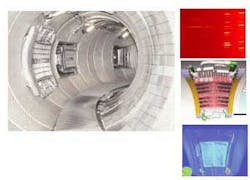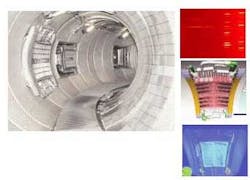Infrared cameras find hot spots in nuclear reactor
The French Commissariat à l'Energie Atomique (CEA) has released the first infrared (IR) images of plasma-facing components in the Tore Supra nuclear-fusion reactor (Cadarache, France) obtained using a network of IR cameras supplied by CEDIP Infrared Systems (Croissy-Beaubourg, France). Initial published results illustrate the spectral distribution of measured energy at different points within the reactor, and the IR images obtained with the CEDIP technology demonstrate the integrity of critical components, such as the toroidal limiter, located in the tokamak (a toroidal plasma confinement device invented in the 1950s).
The plasma-facing components within the reactor are subjected to temperatures ranging from 100°C to 1500°C. CEDIP designed the IR camera technology to operate in a strong magnetic field and provide data across the full temperature scale in a single range. The observation of the inner wall of the reactor was made with 12 indium antimonide focal-plane-array cameras (320 × 240-pixel resolution) located in a remote compartment of the reactor. The cameras are incorporated into a prism spectrometer designed by Optis (Toulon, France), with a spectral range of 1 to 4.5 µm, and connected to IR endoscopes via near-IR-grade silica fibers and zirconium fluoride fibers (see figure). Each endoscope observes a different region of the reactor.
According to CEA spokesperson Roger Reichle, an important feature of the cameras is their enhanced dynamic range, produced by combining inside the camera three consecutive frames taken with different exposure times. In addition, the output frequency reaches 50 frames/sec.
As a result, the IR images obtained with the CEDIP cameras show a large number of widely separated hot zones inside the tokamak. The hot zones in question are the leading edges of deflector plates that channel the hot exhaust gas of the fusion plasma into pumping ducts. The top layer of the deflector plates, which is in contact with the plasma, is a carbon-fiber-reinforced-carbon (CFC) shield 5 mm thick. This CFC cladding is intimately connected to a copper-chromium-zirconium support structure intensely cooled by internal water channels. The power flux that can be handled in steady state by this device is about twice as high as on the leading edges of the wings and the nose of a reentering space shuttle and about four times smaller than the heat flux directly on the surface of the sun.
Because it is possible to approach this limiting value in full-power operation of the tokamak, the IR surveillance helps reduce the power flux when needed. The light from the fibers is spectrally dispersed by a sapphire prism in front of the camera. From these spectra the temperature of the hot zones is determined either by analyzing the absolute intensity at a given wavelength or the relative intensities at two or more wavelengths.
According to CEDIP, by accommodating the core detector and processing electronics in a low carbon steel to shield the internal camera parts from the magnetic field, this system demonstrates the thermal sensitivity, dynamic range, and image acquisition speed necessary to operate in the harsh internal environment of a nuclear fusion reactor.

